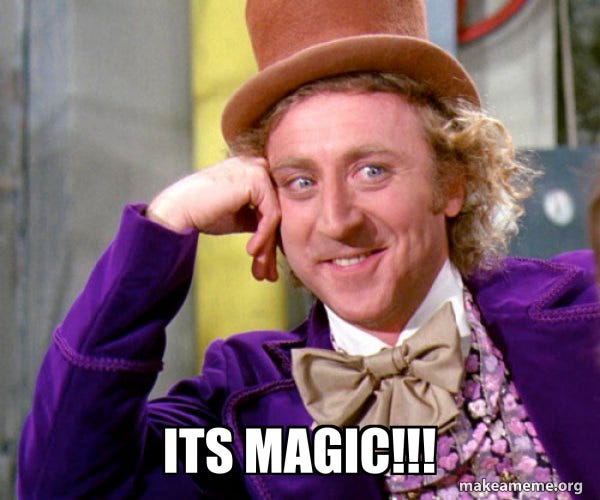On Catching Magic, Even in Software
Connecting the dots between creative magic and building software
In the summer of 2023, I saw John Mayer play live for the first time and it changed my life. People often talk about how incredible seeing their favorite artists live is. I could say the same. I was one of thousands marveling in Madison Square Garden, as John played solo. No band, no accompanying singers. Just him and his full range of musical talent on display. The piano, harmonica, all types of guitars, no guitars. He did it all. I remember thinking after the concert, “how the hell is this guy human?” He was so talented that my brain couldn’t process it.
But there was one moment in that concert I’ll never forget. A moment so special and so strong, it felt magical. It was during John’s song “Stop this Train” where he sings about how fast life hits you. How quickly you grow up and get older. And that nostalgic yearning to slow it all down, just to be young again.
Stop this train
I wanna get off and go home again
I can't take the speed it's moving in
I know I can't
But, honestly, won't someone stop this train?
It’s a song that everyone feels in their heart. The entire arena was on its feet, singing each word. Not just singing along, but singing the feelings from their souls. You could feel the complexity of emotion.
The turning point of the song is when John talks to his dad, and uncovers some profound truths about life:
So scared of getting older
I'm only good at being young
So I play the numbers game to find a way to say that life has just begun
Had a talk with my old man
Said, "Help me understand."
He said, "Turn 68
You'll renegotiate
Don't stop this train
Don't for a minute change the place you're in
Don't think I couldn't ever understand
I tried my hand
John, honestly, we'll never stop this train
Oof. I remember thinking I’d heard this song over 100x before but I’d never had it hit me the way it did in that moment. For me, that single moment defined the concert. I can’t listen to that song anymore without being transported back to that moment and that feeling. I felt by myself moved in an almost inexplicable way. And I know I wasn’t alone in that moment. It was a shared experience with thousands of others in the crowd. We all felt the magic.
What is Magic?
Since that concert, I found myself reflecting on where else I’ve experienced these powerful moments of magic. Does it just exist at concerts, or in listening to well-written music? Intuitively, I know that’s not true. But I’ve struggled to accurately define this feeling.
Let me take a stab at describing what I believe is magic, more broadly.
Magic is the feeling of something deeply human and inexplicably moving. It sparks joy, awe, wonder, or even sadness, effortlessly settling the mind and drawing you into the moment. It can be fleeting or linger, but it stays with you, reshaping how you see or experience the world. Magic is hard to define, but undeniable when you feel it—an enchantment that transcends understanding.
The Best Creators Know What Magic Is, Even in Software
When we think about where we experience magic, we usually look to creative domains. We think about feelings we felt when listening to a beautiful song, reading a great book, watching an exceptional movie, staring at a piece of art, or traveling to a unreal corner of the world. We equate moments of magic to observing beauty.
But we also experience so much of the world, online. We stare into our phones, TV screens, laptops. Yet we don’t often consciously think about our experiences using digital products as magical.
I’ve built software and digital experiences for 10+ years now. While there were many aspects of building that I did find creative, I did not always view my work as inherently creative. I looked at myself different than artists and creators, in the traditional sense. Because I thought I was in the business of solving people’s problems with design and code. Or in the business of making tough tradeoffs to bring visions to life.
But I’ve realized working with the best creators, that all of us can view building software as inherently creative too. I’ve reframed the way I see my work, and what I’m in the business of. It goes back to the first time I heard the word “magic” in the context of building software. It was while I was a PM at Google. Product and design would often talk about finding our edge with a new feature. There was a cultural understanding that it wasn’t just about checking off the boxes. It was about recognizing that building something great required going above and beyond. I didn’t fully understand it but I could sense there was a high bar.
When I came to Figma, I kept hearing similar things. We obsessed over the details in our designs. We paid close attention to the whole journey, including all the edge cases. We didn’t just do everything you were supposed to do in designing great software. We went way above that. We agonized over tradeoffs in terms of human emotions. We unapologetically obsessed over the user. And then I started understanding it more. I started connecting the dots. These values are part of what makes our products great.
Building software is inherently a creative endeavor. And the best software builders understand you can create magic for users when you build with this mindset. The same way the best creatives and storytellers know how to invoke emotion to deliver a message. Empathy is the key. Builders who can imagine the emotion of someone else, and understand what they need in that moment. It’s the same thread of magic that makes the lyrics of John Mayer’s song hit home.
I know this sounds idealistic. But think about it. Are there great software products you’ve used that pulled on some real emotion for you? Maybe a sense of awe? Recently, I have these moments so often with AI. I’ve experienced it numerous times with ChatGPT…where I often feel like I’m talking to another being with some semblance of intelligence. I feel this kind of magic, even though I know enough about LLMs to know what’s really happening under the hood. That’s the inexplicable contradiction of magic. It makes sense, but it somehow doesn’t.
I recognize these moments even in more “boring” pieces of software. And maybe it’s not exactly magic, because the novelty has worn off. But the emotion is still there. When I use Zelle to send money online or a my wife uses Justworks to handle payroll for her employees. There’s a feeling of relief and trust that is at the end of the day, attached to pieces of software. That software connects to real human needs.
The best builders carefully craft experiences to invoke those feelings. I’m not here to argue all software is art or that every builder has this view. But I am idealistic enough to say all software exists to solve some human problems. There’s a choice to view your work in technology as not fundamentally creative. But reframing your mindset to be grounded in empathy can lead to building exceptional pieces of software. Making your users feel good is an edge. And I think that matters even more in the future we’re headed into.
Catching Magic as Builders
The other day, I stumbled across a clip of an actor, Jason Segel, talking about one of my favorite TV shows: How I Met Your Mother. He describes a scene where his character learns his dad has passed away. The catch is that Segel filmed the scene in one take, without knowing the script reveal ahead of time. So Segel’s entire reaction is raw and pure in a way that can’t be recreated. A moment of acting magic.
Segel later said:
"It's what I've come to really like about my job, like what I think is the most exciting thing that you're trying to do, which is catch something, catch it on camera"
You then have to get good, like the craft is repeatability and all that stuff 'cause you're gonna do a lot of angles. But the magic is like, oh, we caught something real there for a second”
I love that. If you are in the business of bringing something to life, your work is creative. Each of us has the potential to catch magic in what we do.
To catch magic, start by asking yourself: How will this make someone feel? Put yourself in their shoes and imagine their experience. Will it spark joy, awe, or relief? Will it solve a problem in a way that feels effortless or even delightful? Magic happens when you design with empathy, when you sweat the small details that others might overlook, and when you allow yourself to care deeply about the human connection your work creates.






